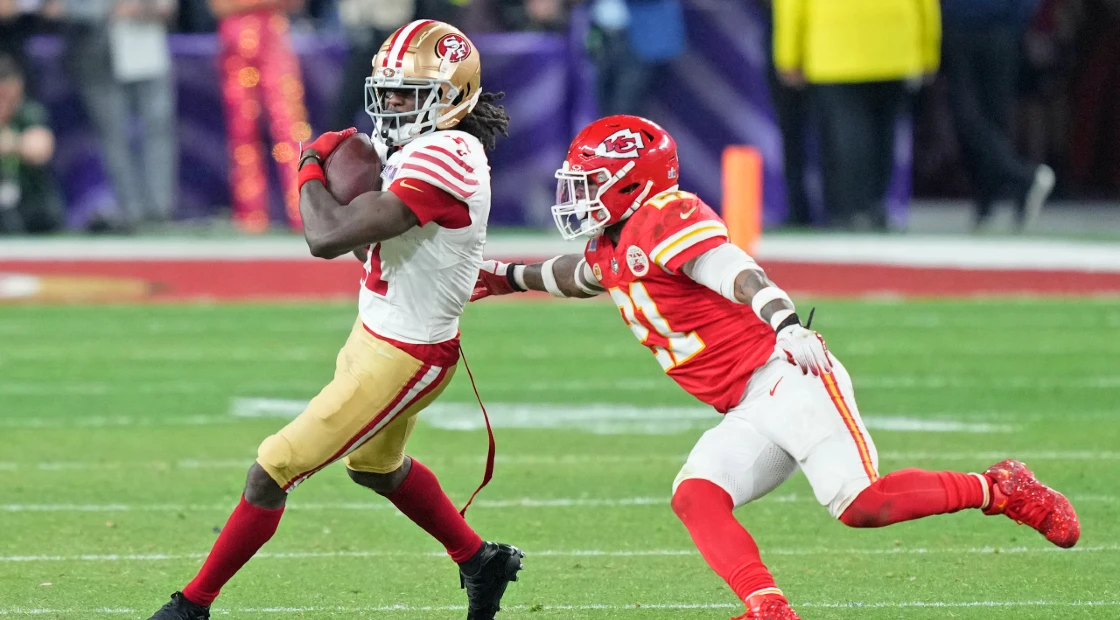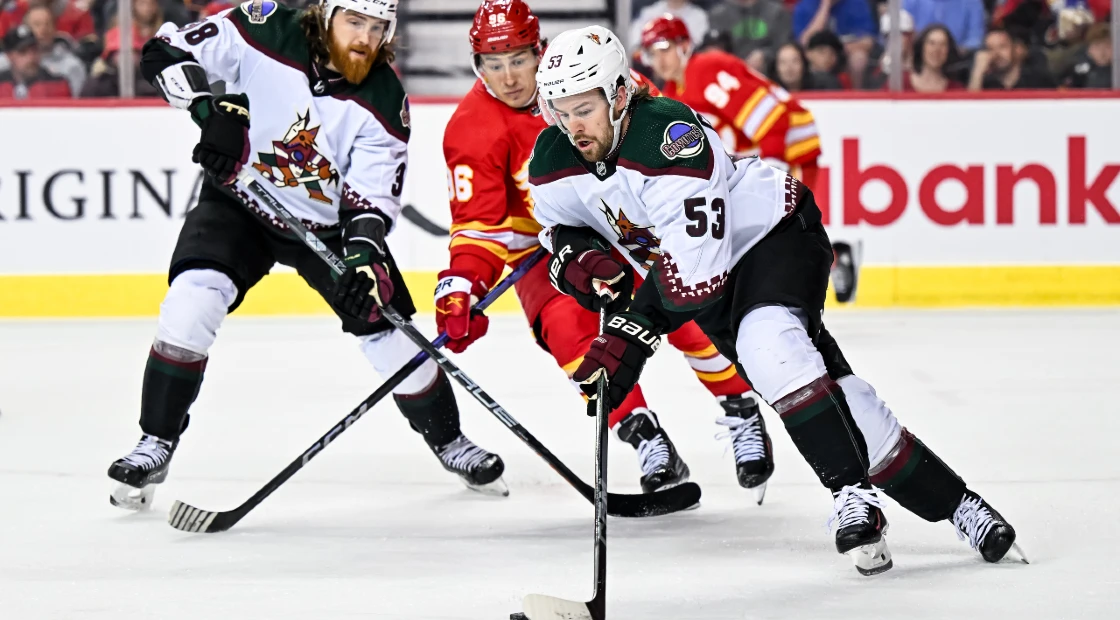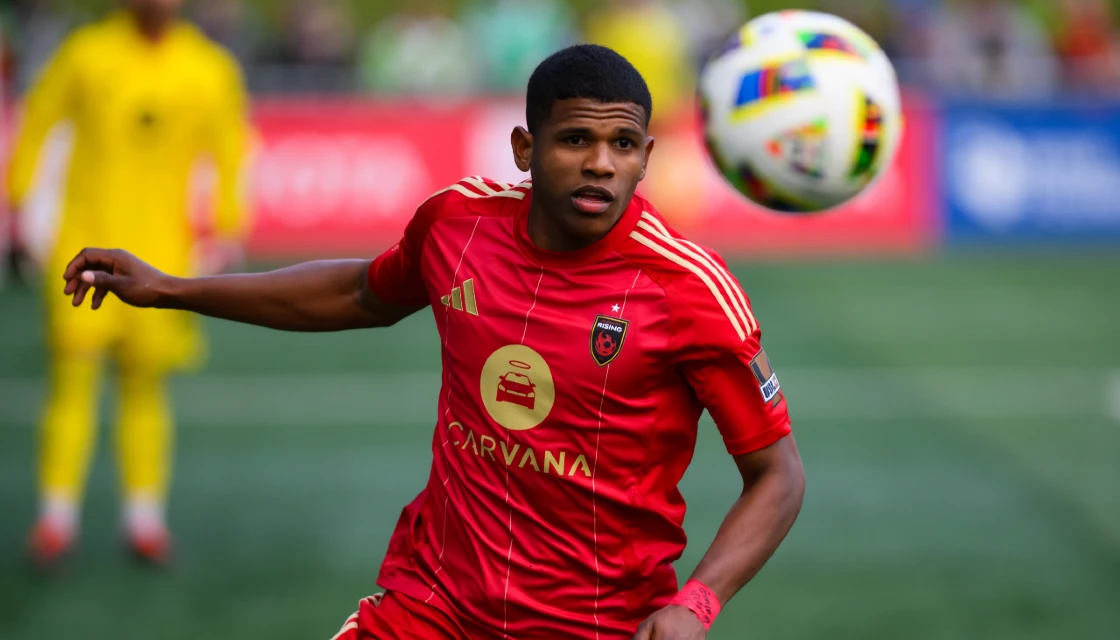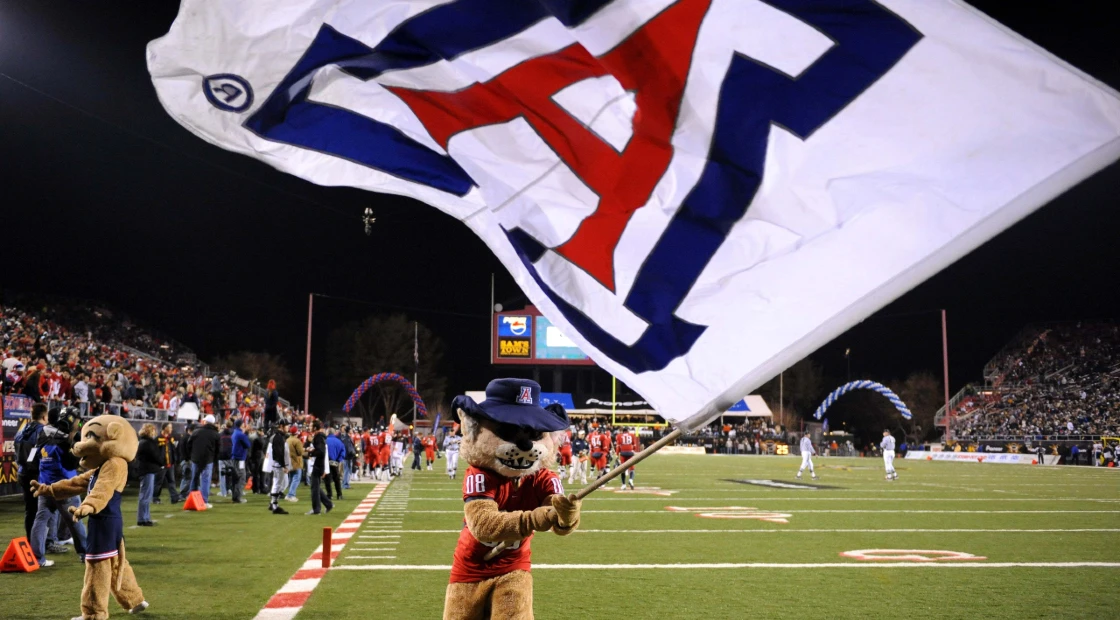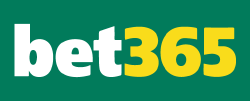Potential Sponsorship Earnings of the Top 25 College Athletes in Arizona
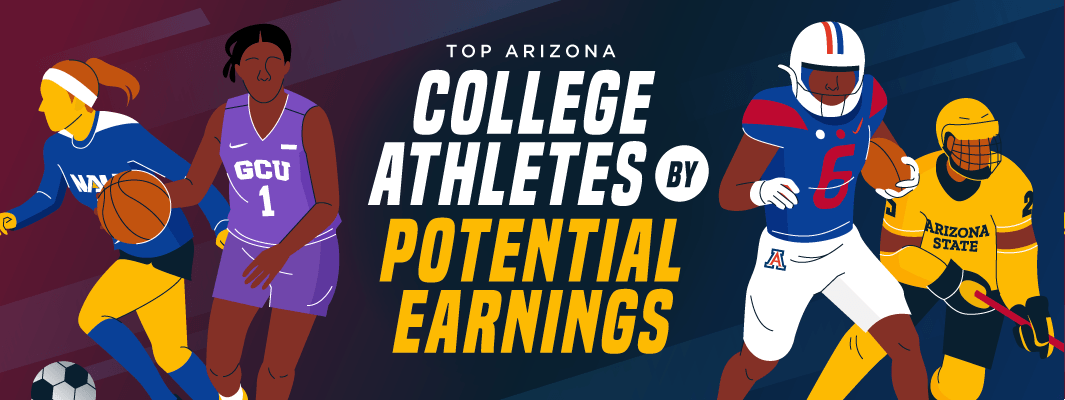
Previously, NCAA athletes were prohibited from accepting sponsorships or paid agreements with brands. Nevertheless, a recent ruling by the NCAA has changed this regulation, permitting student athletes to earn income through their name, image, and likeness. We analyzed the social media followers of all Division I athletes in Arizona to identify who stands to gain the most from this fresh opportunity.
Athletes will be permitted to profit from their personal brands starting in July 2021, according to the NCAA.
In the past, student athletes were prohibited from accepting endorsement deals, brand sponsorships, or any form of compensation for their name, image, and likeness (NIL) in order to maintain the principle of amateurism. This principle underscores that student athletes are primarily students and not professionals, and should only be rewarded with scholarships, rather than additional payments.
Nevertheless, two significant trends converged to weaken this core principle of the NCAA.
In recent decades, college sports have experienced a substantial rise in profitability, generating billions of dollars in revenue through ticket sales, merchandise, and television contracts.
With the rise of social media, keeping track of athletes’ personal accounts for NIL rights has become increasingly difficult and may encroach on their privacy.
Arizona SB 1296, enacted on July 23, 2021, allows athletes to pursue endorsement deals, hire agents, and promote their own businesses. The NCAA has stated that players must follow their state’s NIL laws, and schools are responsible for ensuring compliance with state regulations.
How can college athletes make money from their Name, Image, and Likeness (NIL)?
Numerous college athletes leverage sponsored social media content and advertising partnerships as the main avenues to enhance their personal brands.
The NCAA’s latest regulation permits elite college athletes to sign lucrative sponsorship agreements with popular brands, while those with smaller audiences can still serve as brand ambassadors for businesses in their college communities due to their social media influence.
College athletes would have the chance to make money from their Name, Image, and Likeness through selling autographs, merchandise, training programs, or endorsing other businesses, in addition to social media and advertising.
What is the expected earnings for college athletes?
The amount a college athlete can earn from NIL marketing will primarily depend on the size of their social media following.
Athletes with a small following could earn $1,000 to $3,000 per year by strategically managing their personal brand, while top athletes with a large following have the potential to make six or seven figures annually by partnering with major sports brands using their Name, Image, and Likeness (NIL).
Which Arizona college athletes have the highest earning potential?
We want to find out which Division I athletes in Arizona have the highest potential to earn money through marketing their Name, Image, and Likeness (NIL) following the NCAA’s recent ruling.
There are four universities in Arizona that have Division I athletics teams, with a combined total of 23 teams competing in eight different sports.
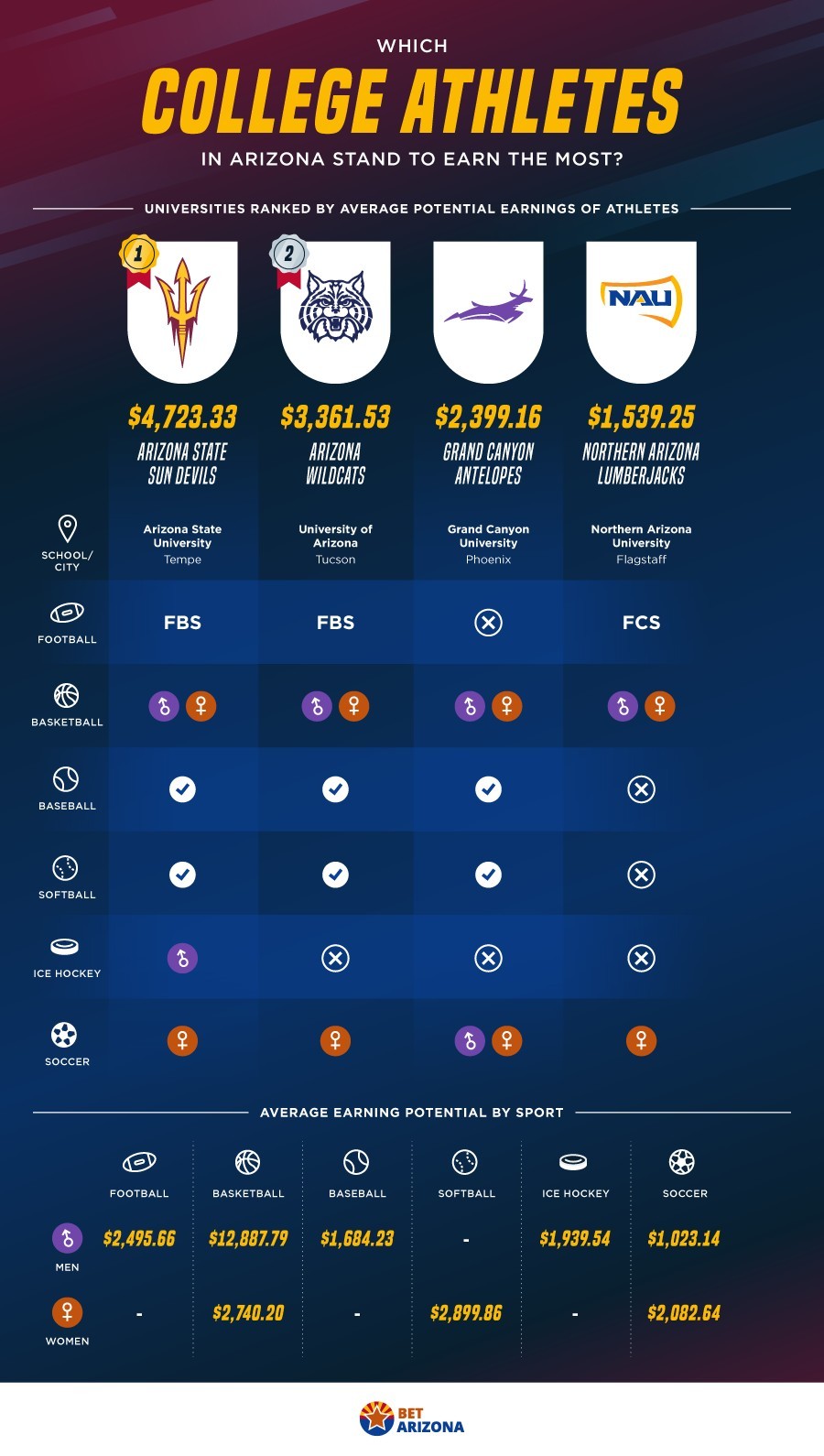
We tallied up the total number of Twitter, Instagram, and TikTok followers for each player on the current team rosters. Using a yearly value of $0.80 per follower, our goal was to investigate how student athletes can earn real income through a mix of sports talent and social media presence.
Key Findings
- Men’s college basketball players in Arizona typically have the greatest potential for high earnings compared to athletes in other sports. At present, only five players have a large enough following to make over $50,000 per year, with four of them being men’s basketball players.
- Female basketball and softball players at Arizona universities typically have a larger social media following than their male football counterparts.
- ASU athletes have the highest average number of followers (5,904) and potential earnings ($4,723) among athletes from UA, GCU, and NAU in all sports.
- Marcus Bagley, a student athlete at Arizona State University, has the greatest potential for earnings among athletes in Arizona. As a member of the men’s basketball team, Bagley has nearly 360,000 followers on Twitter and Instagram, which is more than three times the number of followers of the athlete with the second highest count.
The top 25 highest-earning potential athletes in Arizona college sports
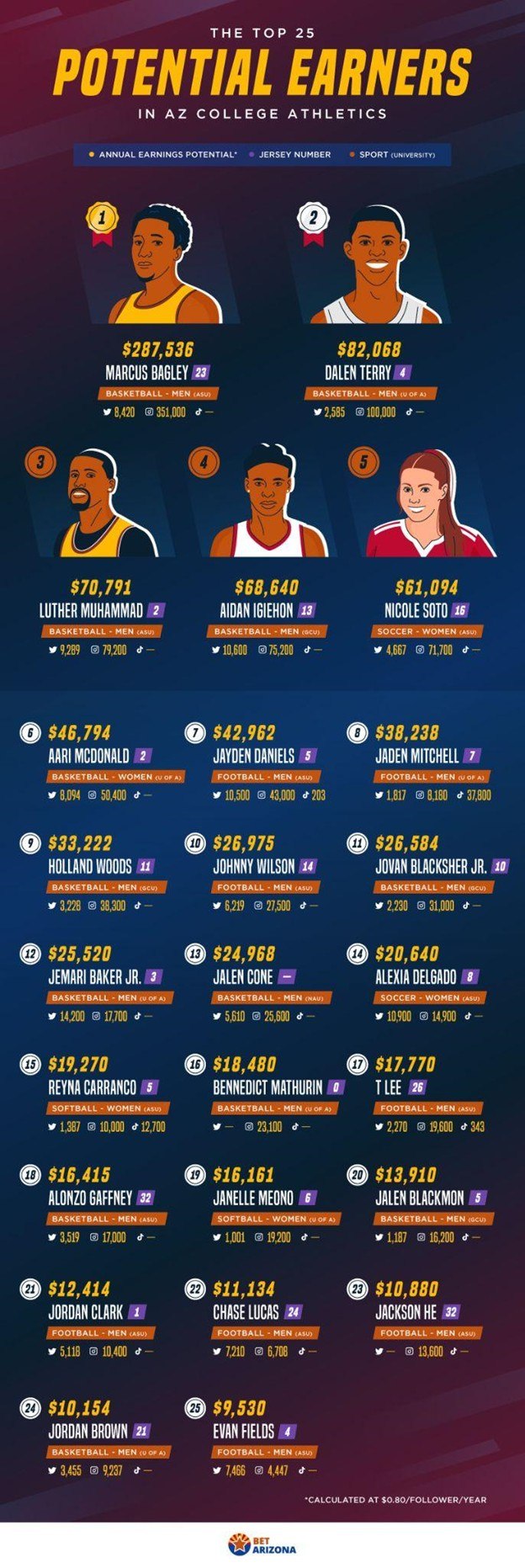
Men’s basketball players overwhelmingly occupy the top spots on the list of Arizona’s most-followed student athletes, with Marcus Bagley (ASU), Dalen Terry (UA), Luther Muhammed (ASU), Aidan Igiehon (GCU), and Holland Woods (GCU) making up five out of the top ten individuals.
Nicole Soto of the ASU women’s soccer team and Aari McDonald of the UA women’s basketball team both hold positions in the top 10 list, with Soto ranking at number five and McDonald at number six.
In addition, Jayden Daniels (ASU), Jaden Mitchell (UA), and Johnny Wilson (ASU) are among the top 10 football players. Mitchell stands out with his impressive TikTok following of 37,800, even though he has fewer followers on Twitter and Instagram than his fellow players.
What sports receive the most focus on social media?
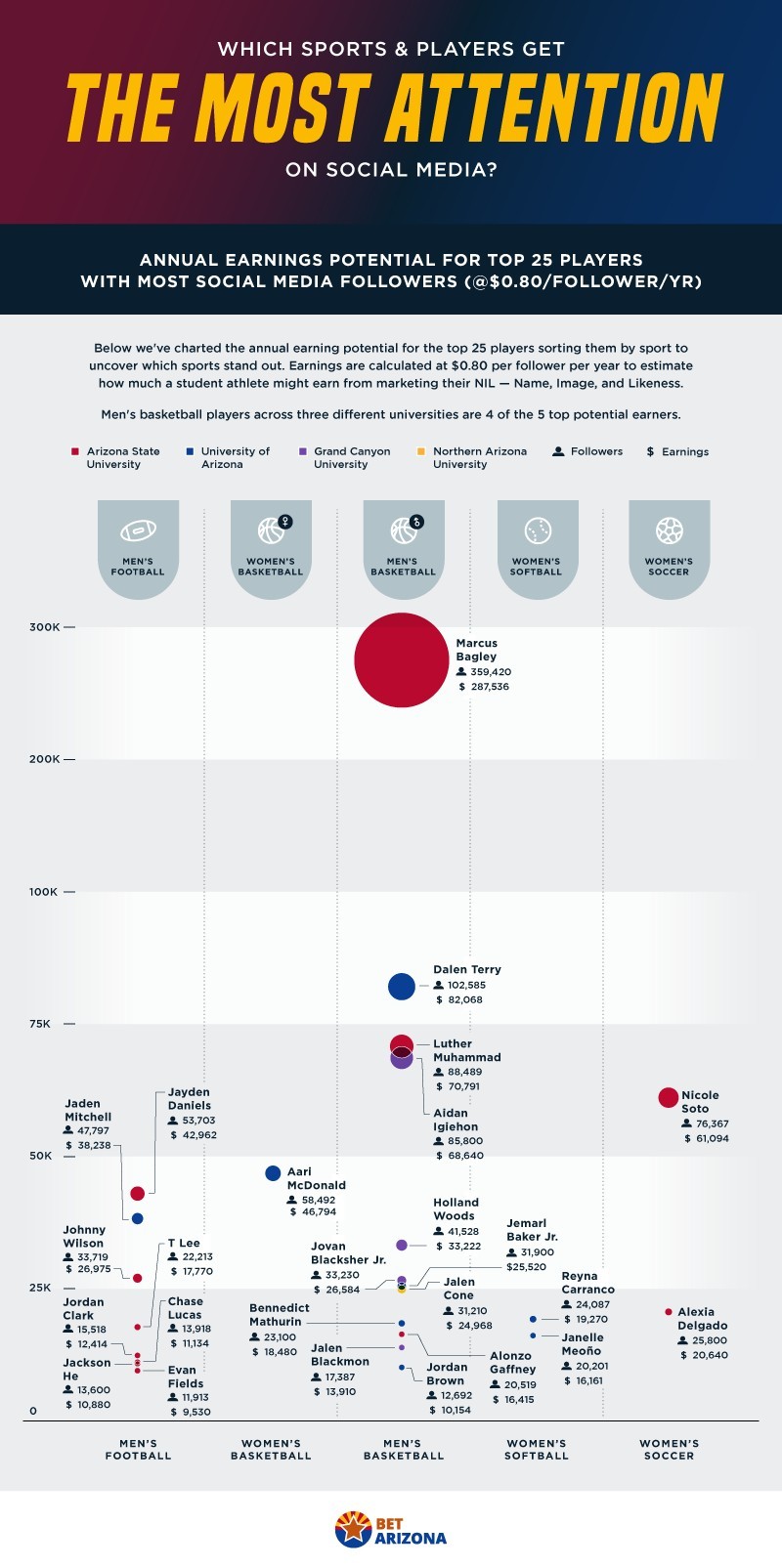
According to BizJournals, in 2018, football was the main source of income for the athletic departments at UA and ASU in Arizona, contributing 42.3% and 38.3% of their revenue respectively. This trend is consistent with Division I NCAA sports nationwide where football serves as the primary revenue driver.
Yet, ticket sales do not always correlate with an increase in fan base for individual athletes.
In Arizona, men’s basketball is the most profitable sport for college athletes, as players typically have over five times the number of social media followers compared to football players. As a result, basketball players in the state have the opportunity to earn an additional $10,000 per year.
Female basketball players at Arizona universities have, on average, around 10% more social media followers than football players, suggesting that it is not only men’s basketball that surpasses football in terms of social media presence.
Female athletes have the potential to earn significant amounts of money as well.
The unequal funding between men’s and women’s sports is a significant and well-known problem. A recent study by Global Sport Matters found that female college athletes receive less than 4% of media coverage on traditional media platforms compared to male athletes.
Nevertheless, social media does not adhere to the conventions of traditional media outlets. Thanks to the recent ability for college athletes to benefit from their Name, Image, and Likeness (NIL), numerous female athletes now have the opportunity to earn more than their male counterparts.
Women athletes at Arizona universities typically have 30% fewer social media followers than their male counterparts across all sports and schools, but the gap in followers varies depending on the specific school and sport.
The UA women’s softball team boasts an average of almost 6,000 followers per player, significantly more than the men’s baseball team which only averages 2,200. The softball team is considered one of the most successful in the Pac-12, having won 11 NCAA conference championships in the last 20 years compared to the baseball team’s three.
Even though women’s sports may not always get the same level of attention from fans, it is crucial to acknowledge the influence of female student athletes. In Arizona, 5 out of the 24 college athletes have the opportunity to make more than $10,000 annually by effectively monetizing their Name, Image, and Likeness (NIL).
NIL Rights are a game changer for numerous student-athletes.
Only a handful of student athletes in Arizona possess the ability to generate substantial income by utilizing their Name, Image, and Likeness. Nonetheless, even modest earnings could greatly benefit these students’ lives and opportunities for the future.
Student athletes, who are often from low-income backgrounds, would greatly appreciate even a small annual stipend to help offset the financial burden of their rigorous training schedules, which make it difficult for them to hold part-time jobs while in school.
Only a small fraction of NCAA athletes, less than 2%, go on to play professionally after college. In Arizona, this equates to just 15 out of more than 700 Division I student athletes from four universities. Historically, student athletes rarely made money from their sports, aside from scholarships. Given the slim chances of going pro and limited financial rewards, very few student athletes even thought about pursuing a career in sports after graduation.
Additionally, there are still many unknowns surrounding NIL and college athletics as universities and states struggle to understand the rulings. The situation is uncharted and filled with potential challenges and unclear areas.
The recent opportunity for student athletes to earn money from their name, image, and likeness rights could provide them with the financial backing necessary to remain involved in the sports world. This extra income might inspire them to put in more effort during their training sessions or consider a future in the sports field, ultimately influencing the trajectory of their athletic careers in a meaningful manner.
Methodology
This is the approach we utilized to assess the earning capacity of student athletes in Arizona:
- Our analysis centered on Division I sports teams in Arizona, including 23 teams across eight sports at four universities.
- We gathered a list of athletes by utilizing the most recent rosters released by each university, primarily from the Spring 2021 or Fall 2021 semesters.
- In the initial week of July 2021, we conducted a thorough investigation to determine the combined number of followers on Instagram, Twitter, and TikTok for every player on the team. In cases where an account was inaccessible or set to private, the player was given a follower count of 0 for that specific platform.
- We estimated a student athlete’s potential earnings from marketing their NIL by using a rate of $0.80 per follower annually.
- Athletes who did not have a social media presence that was publicly visible were not factored into the calculations for averages.
- Analyzed the raw data of each athlete listed in the spreadsheet.
Sources

Author
Referenced by leading media sources, such as:

